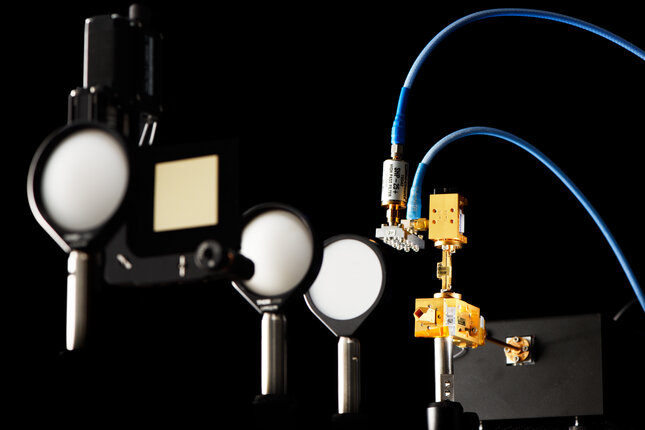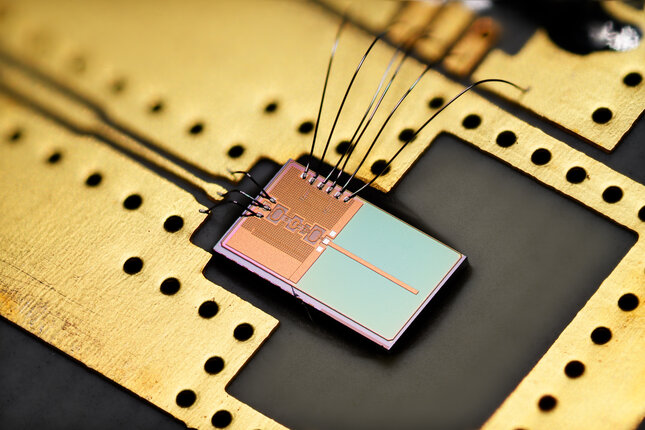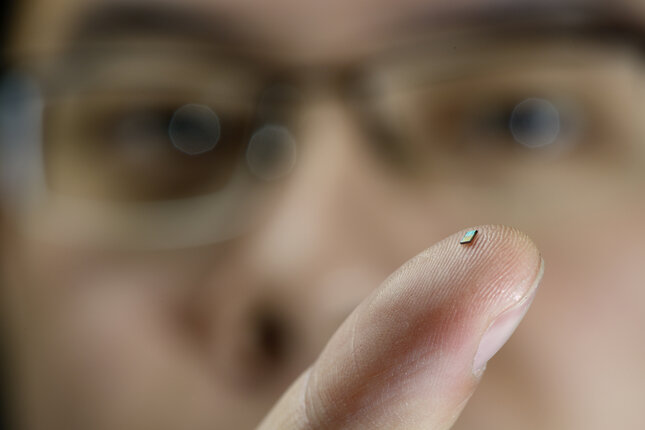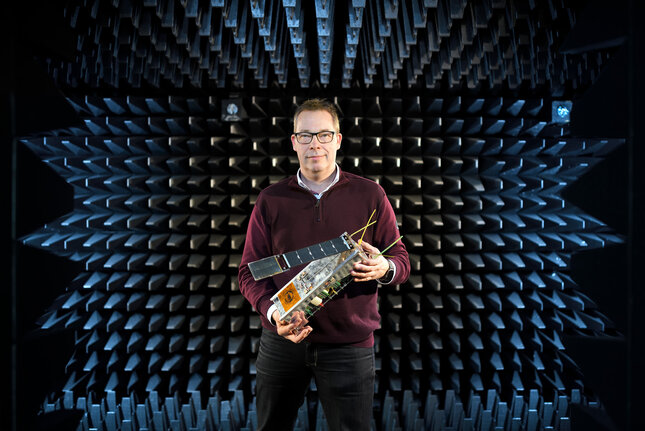The waves of our wireless future
How TU/e is bringing the next generation wireless technology within our grasp.

From a bacterium that is invisible to the human eye to the full length of a football field: the electromagnetic waves that inhabit our world literally have all shapes and sizes. And each type has its own specific use: from the new generation of lightning-fast internet on your phone to revealing the Dark Ages of our universe. And from a Wi-fi network based on light to ultra-tiny sensors that form an ever-extending Internet of Things. Let's travel along the different dimensions of the waves that TU/e uses to shape our wireless future.
- Waves the size of a bacterium
[400 - 1400 nm / 750 - 215 THz]
- Waves the size of a raindrop
[0.03 - 3 mm / 10 THz - 100 GHz]
- Waves the size of a coffee bean
[4 - 11 mm / 80 - 26 GHz]
- Waves the size of an ant to a blue whale
[5 mm - 23 m / 60 GHz - 13 MHz]
- Waves the size of a soccer field
[10 - 100 m / 30 - 3 MHz]
Waves the size of a bacterium
Lighting up your wifi
Until now, our wireless world has been built on radio waves. But how long will it stay that way? "A turning point is coming," says Jean-Paul Linnartz, TU/e professor of Signal Processing Systems and Research Fellow at the company Signify. "We can go a long way with radio waves, with 5G and beyond, but looking at the extreme capacity that will be required in, for example, virtual reality or online gaming, you cannot ignore light."

An important advantage of light is the reliability and lower susceptibility to interference than our current WiFi. For example, light does not pass through walls, which makes it extra safe and does not suffer from disturbances from the outside. Not passing through anything, also presents a big challenge." Put your hand in front of it and the signal is gone, which is often seen as a major drawback," says Linnartz. That is why he is working on so-called MIMO systems (Multiple Input Multiple Output), which send signals to each user from different directions simultaneously with multiple LEDs in the ceiling. Should one of those parallel data flows be interrupted, there is still plenty of capacity left.
Linnartz works also on intelligent lighting systems. He sees this as an excellent basis for the Internet of Things (IoT), in which a growing number of wireless devices can connect to each other per room. In the European Horizon 2020 project ELIoT, which Linnartz is leading, he is working on the necessary infrastructure that can serve as the basis for such an IoT, such as the LEDs and photodiodes in the ceiling and chips that can process the light signals.
While Linnartz focuses on the use of widely available LEDs, his colleague Ton Koonen prefers the use of lasers. With wavelengths in excess of 1400 nanometers, these signals are not harmful to the eye. Koonen already achieved dizzying speeds of 112 Gbps, two thousand times the capacity possible with current Wifi systems. His approach is similar to Linnartz's, using controllable, narrow laser beams that send large amounts of data to the user's devices in an energy-efficient and secure manner.
Waves the size of a raindrop
CLOSING THE GAP BETWEEN ELECTRONICS AND OPTICS
The region between 100 GHz and 10 THz – known as ‘the Terahertz-region’ – is largely uncharted territory. “These frequencies are actually too high for electronics and too low for existing optical techniques,” says Marion Matters-Kammerer, professor of THz circuits and systems at TU/e. At one end of the gap you have infrared optoelectronics, which is unable to operate below 10 THz, as the photon-electron particle interactions generate so much heat that the necessary cooling equipment is too costly and heavy. At the lower frequency end you are dealing with semiconductor electronic devices, where the pn-junctions limit the speed of the charges to around 100-150 GHz.

"We want to try to move electronics to higher and higher frequencies, in order to make handy terahertz sources and detectors," says Matters-Kammerer. "The frequencies that we can handle with standard chip technology are becoming higher and higher, and we also use so-called non-linear components to achieve even higher frequencies."
In the CWTe lab in Flux, experiments are already being conducted with frequencies up to about 0.5 THz. The setups contain a lot of mirrors and lenses, components that are also used for steering laser light in the right direction. “The similarity with optics is strong indeed,” she says. “That’s what I like so much about this field of study; that it merges electronics and optics. I myself graduated in laser physics, so I am quite familiar with lenses and mirrors.”
If people like Matters-Kammerer will be able to master this ‘Terahertz region’, countless exciting applications come within reach, like medical imaging technologies to look just underneath the skin, or scanners that can see through clothes, paint or plastic to monitor invisible damage. The group is also looking at fruit and plants, in collaboration with Wageningen University, to check for ripeness and rot in agricultural produce.
Waves the size of a coffee bean
SMART ANTENNAS FOR 6G
Even though 5G is already making its appearance, the real breakthrough will only come in 2025, when the fastest form of 5G is introduced, a 100 times faster than the current 4G, from 100 Megabit per second (Mbps) to 10 Gigabit per second (Gbps). "And in 2030, we expect the introduction of 6G, which will again be 100 times faster, to one Terabit per second (Tbps)," says Bart Smolders, professor of telecommunications at TU/e.

Smolders and his team are global pioneers in the development of the antenna technology needed to enable the blazing fast networks of 5G and 6G. These networks use signals at much higher frequencies – from 3.5 GHz for the current 4G to 26 GHz and higher for the fastest form of 5G and 6G – and that requires completely different antennas and base stations.
“Currently, 4G antennas send everyone's information to everyone at the same time. This technology is now very close to the capacity limit. Therefore, to be able to go to 5G and beyond, we need a completely different type of antenna, ” says Smolders. These 'smart antennas' have been developed at TU/e in recent years and are now being prepared for practice within the EU funded MyWave project worth 4 milllion euros. This project started last year, including partners such as Ericsson and NXP.
As a user, you only get the data you need from these smart antennas. These antennas can therefore be oriented, so that each user receives their own bundle of information, which is not done mechanically like a satellite dish, but electronically. “Each antenna, with tens to hundreds collected in an array, has its own chip,” says Ulf Johannsen, who works on these antennas. “This chip calculates a delay in the processing of the signal, such that the viewing direction is adjusted electronically.” What is special about this is that the TU/e antennas are integrated directly in the chip. This integration provides even better signal strength and higher data speed.
TU/e focuses not only on technology for consumer products, but also for base stations. Even higher frequencies of 80 GHz are used here. Within the spinoff company MaxWaves, the technology has been developed into a demonstrator, the first step towards a prototype. The first practical test was successfully completed at TU/e last year.
Waves the size of an ant to a blue whale
ULTRA LOW-POWER SENSORS
“Through measurement to knowledge" was the credo of famous Dutch physicist Heike Kamerlingh Onnes. No better label fits the proliferation of sensors that monitor and report the world around us, be it temperature, light, humidity, freshness of food or heart rhythm. They form the basis of a growing (industrial) Internet of Things (IoT) in which everything is connected.
A research line has been set up within TU/e's CWTe that revolves entirely around the development of ever smaller chips and sensors that communicate with each other. The range of frequencies is quite wide, due to the varying requirements of different applications.

The energy requirement is a major challenge. "If you can make IoT sensors very small, they almost inevitably become cheap and the barrier to having a lot of them everywhere becomes very low," says Peter Baltus, professor of microelectronics. "That's fine, as long as you don't have to replace batteries."
To arrive at smart, energy-efficient solutions, according to Baltus, the strength of TU/e is combining unusual new concepts for specific applications, in close collaboration with industry. In contrast to, for example, the evolutionary squeezing of the same concept. Look for example at this innovative swarm of 'smart marbles', that can monitor pipes for defects, and could perhaps one day explore the inside of volcanos or even the human body.
Illustrative of this is the two millimeter-small temperature sensor of Baltus' group, which draws its energy from the radiation of the wireless network of which it is a part. Other examples are the sensors with flexible electronics for temperature measurements in food packaging, or the highly energy-efficient radar sensor (<1 mW),which can monitor someone's heart rhythm at a distance of fifteen meters, for use in, for example, smart home technology.
This is a challenge and opportunity for artificial intelligence at the same time. Ultra dense networks need to be well controlled to reduce interference, as the transmission range of a sensor will overlap with the range of many others. "It is like having many people in a single room and they all want to talk," says George Exarchakos, who leads this line of research. This density is an opportunity as well. "We study the computing capabilities of dense wireless networks considering each device to be part of a big neural network. Imagine the capabilities if our sensor networks were not only data generators and data pipes to clouds but processors as well. We could be approaching the era of real pervasive computing."
Waves the size of a soccer field
REVEALING THE UNIVERSE’S DARK AGES
Of the initial period of the universe, up to roughly four hundred million years after the Big Bang, we still know very little. What we do know of these so-called Dark Ages is that the universe must have been immensely hot, and a great deal of heat radiation was released when particles collided with each other. Today we can see this radiation in the form of radio waves, because as the universe has expanded the waves have been massively stretched up to tens of meters in length.
Detecting these ultralong waves on Earth is limited due to the protective effect of the ionosphere, but also due to the disruptive impact of radio signals generated by humans. According to Mark Bentum, professor of Radio Science at TU/e, a space or lunar-based ultra-low-frequency (also referred to as ultra-long-wavelength, ULW) radio array would suffer significantly less from these limitations. It could open up the last, virtually unexplored frequency domain in the electromagnetic spectrum.

Together with other astronomers and researchers Bentum envisions a space-based ultra-low frequency radio telescope, dubbed OLFAR (Orbiting Low Frequency Antennas for Radio Astronomy), comprising a swarm of nano satellites equipped with antennas that are 5 meters long. One major challenge of Bentum is to find a way to fit those inside a small nano satellite during launch, before ‘inflating’ them when arriving at the destination in space.
Bentum works in strong collaboration with the Radio Lab of Radboud University (RU). Last year both institutes launched the Center for Astronomical Instrumentation (CAI), to develop astronomical devices at the limits of technological possibility. In collaboration with renowned institutions such as ASTRON, SRON and NOVA, CAI hopes to contribute to the international position of Dutch astronomy in domains such as radio, optical and gravitational wave astronomy, and in technological innovation for space travel.
Help us shaping the digital future
Are you interested in our research on wireless communication? Want to join our researchers in their goal to shape our wireless society? Check out what TU Eindhoven has to offer.
